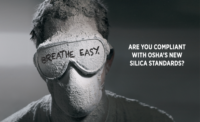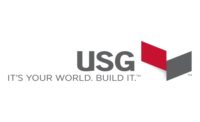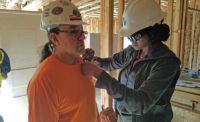Jobsites are notoriously challenging environments for contractors. Dust and noise hazards present obstacles to construction contractors as well as the general public within the vicinity of projects. However, the release of OSHA’s silica control standards prompted construction contractors to counteract the risks that this dust may present.
OSHA’s standard 29 CFR 1926.1153 outlines the limits for silica exposure in construction activities. As a manufacturer of pumps and mixers, our time on the jobsite has proven that there are several questions in the field about silica compliance. Both contractors and manufacturers have developed their own unique and varied solutions to meet compliance requirements.
Recognition of these dust issues within our industry benefits contractors in the field while protecting the general public’s comfort and safety.
Next-Generation Workforce Concerns
Over the last ten years, our industrial workforce has become challenged by the lack of next-generation workers entering the trades while undergoing an increase in construction projects. Our industry is under more pressure than ever to create a work environment that’s safe and more appealing to attract this essential new generation of trades workers.
Today’s young workers carry with them expectations that include advances in technology and on-the-job comfort. In construction, this translates to positions with less manual labor and improved safety conditions. With these generational demands, dust control becomes a topic beyond compliance.
Construction technology and equipment advances are pacing with these expectations to ensure that dust is contained, collected, and removed from the process. Effective and often complete dust containment is achievable using today’s advanced equipment, with little or no personal safety equipment required.
In addition to workforce and regulations, contractor readiness is imperative to win jobs within areas that carry these compliance requirements.
Public Health Concerns at High-Traffic Jobsites
Silica dust concerns don’t stop at on-site construction workers. Many jobsites are within close proximity to high traffic areas utilized by the general public. Recently our team visited a customer’s large construction project at a major U.S. airport where renovation was taking place inside several terminals.
This project required the application of fireproofing materials without generating dust or excessive noise. The separation between passengers arriving at the airport and the construction work was merely an eight-foot barrier wall that was open to the same space.
Concurrently, another contractor was surface prepping concrete floors using floor grinders. Both contractors were using HEPA filtrations systems that eliminated the discharge of dust. The floor grinders were remote-controlled. The operator was not only dust-free but also able to control the grinder very comfortably and efficiently with minimal labor and no exposure to dust or silica coming off the machine. This lack of dust contamination benefitted both the workers and passengers in the terminal while meeting OSHA standards.
Equipment Standards to Meet OSHA, Employee and Public Standards
In many cases, jobsites will require both dust and noise regulations. The airport project fireproofing crew used a continuous mixer with HEPA filtration and a near-silent electric hydraulic piston pump during operation. The mixer‘s filtration hood reduced the dust produced to nearly zero. The mixer operator did not have to manually dump the mixer or experience dust plumes, as is typical with fireproofing. Within less than twenty feet of the equipment, workers and the public were not distracted by construction noise.
The job was a success. The employees bypassed dust and noise, and their work was less labor-intensive than ever before.
As I exited the work zone that day, I noticed that seating was available at the top of the escalator along the work wall, with a couple of families seated there. As I walked through in my safety gear, it was clear that they were unaware of the work performed just 50-feet from where they were seated.
The contractor created a work environment to encourage young people into the trades today, and one which assisted in acquiring this regulated large project. We can embrace it or complain about regulations. Still, I expect that the success stories will continue to come from projects where companies use safety to create a work environment that also helps attract the next generation construction worker. They are looking for a better job, and with the tools and innovations available today, our industry can provide it.
— ALLEN MILLS —
Allen Mills is president of HyFlex, a manufacturer of pumps, mixers and sprayers for construction coatings. He is a Purdue ABE graduate and third-generation owner of HyFlex. He continues his father and grandfather’s pursuit of building equipment for contractors that’s highly reliable, and simple to operate and repair. Since 1970, the company has delivered portable electric pumps and innovations in pumping and mixing.






Report Abusive Comment